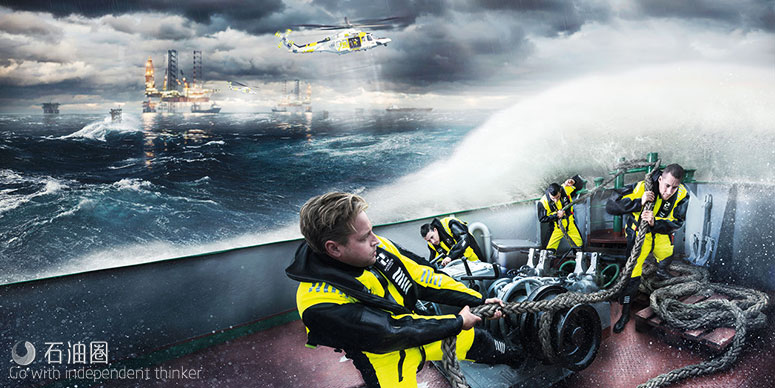
技术在支持油气工业的复苏中已经起到举足轻重的作用。技术可以帮助未开发的储量有效开发,帮助油气工业的工作提高效率,最大限度地开采老化油田。
来自 | E&P
编译 | 张良爽
继钻完井、油田化学等技术介绍后,本期石油圈将从水下技术等方面介绍近期国际石油行业的科技动态。
新式海底检测服务
Lloyd’s Register(LR)宣布将为海上能源公司的海底管道、资产和设施提供新式海底检测服务。服务内容包括适用于ROV、AUV和潜水员的项目管理、咨询、人员管理、质量控制以及数据处理与管理。此项服务由LR海底检测经理Andrew Inglis亲自掌舵,由海底检测、勘查和资产完整性方面的专家支持,为海上油气、风力发电场和海底电缆行业的运营商和承包商们提供服务。在各大运营商开始准备年度水下检测计划之际,LR运用专业知识,通过优化项目规划、执行和交付,发掘多重用户和多项目协同运作的潜力,将帮助运营商们实现水下资产的完整性目标。
协作照亮潜水员安全之路
WFS公司与PhotoSynergy(PSL)公司合作发布了一种新型无线带状照明系统,旨在提高潜水员在远程水下作业时的安全性和效率。Seatooth LIGHTPATH是两种先进技术的组合:出自WFS的Seatooth是一种海底无线通信系统,可以下载并记录收集远程水下安装信息;而PhotoSynergy的LIGHTPATH,则是一种侧向发射的柔性光纤,能够形成不带电的连续光线。该新产品可支持潜水员和ROV操作员在靠近海面或是在深达3000米(9,842.5英尺)的地方进行作业。在水下的黑暗环境中,当潜水员和ROV操作员进入距离设施5米(16英尺)范围内时,即时照明自动开启,亮度足以使作业人员看清设施结构布局和控制阀、对接舱等特征,甚至是设备本身的轮廓;当潜水员或ROV操作员离开现场时,它将自动关闭。在靠近设施、其他潜水员、ROV操作员,或接近危险区域时,LIGHTPATH还可作为警戒提示。目前此项装备已在实验室测试成功,预计将于2017年上半年进行水下环境的试验。
空中机动封井设备
哈里伯顿旗下的Boots & Coots Services公司宣布推出了全球油井干预快速响应服务(Global Rapid Intervention Package)—GRIP,该系列服务旨在降低水下井控事件发生时的响应成本和响应时间。GRIP可提供油井规划和压井服务,由公司的全球物流基础设施和现有的产品服务线提供支持,具体包括油气井测试服务、连续油管设备和救援井测距工具。此外,GRIP特色装备还包括耐高温高压(15,000 psi)的RapidCap空中机动封井设备。该设备由Trendsetter工程公司生产制造,比目前市场上的其它同类产品更轻、更便宜、移动性更好。
重新成像项目提高数据质量
TGS-NOPEC地球物理公司(TGS)和斯伦贝谢公司(Schlumberger)宣布计划在美国中部墨西哥湾区域开发多宽方位角(M-WAZ)多重用户端的重新成像项目。
预计在该地区的区块交易量大幅增加之前,约在2018年初会有最终结果。新的Fusion M-WAZ项目数据包含TGS、Schlumberger和WesternGeco合作的3-D WAZ项目中通过Q-Marine海洋地震系统收集的2008~2012年间的数据,包括超过1000个外陆架(约23,000平方公里或8,880平方英里)的数据。
这个大型重建计划将使用最新的成像技术处理来自密西西比峡谷、阿特河谷和尤英河岸地区的数据,为接下来的开采许可提供高质量的数据支持。未来该地区仍将是勘探开发公司的重中之重,在海洋能源管理局2017~2022年五年计划中,该地区还将从每年两轮的开采许可中获益。
新式水下采样瓶降低操作风险
Proserv公司发布了一款新式水下采样瓶,可以提高检验结果质量并降低样品转移的相关风险。基于现有技术,Proserv水下采样瓶(SSC)是世界上第一个完全合格并经过了认证的适用于水下环境的可“运输”采样瓶。该采样瓶系统能够准确获取油气田整个生命周期中油气井的各项属性参数。使用该水下采样瓶,作业者可从水下采集具有代表性的生产样品,并直接转至实验室。Proserv水下采样瓶降低了发生泄漏和暴露于H2S / CO2的风险。
海底电缆需求增长
Douglas-Westwood公司发布了“海底电缆追踪报告”,从中可以确认船舶安装的日需量,以及按地区划分的所需组件类型明细,并兼顾全球驱动力和发展前景因素。 Douglas-Westwood预计,在接下来的五年内,海上风电市场的强劲发展将拉动海底电缆需求大幅增长。Douglas-Westwood发布的海底电缆追踪报告,正是为了帮助企业了解这一需求增长的规模和范围。追踪报告指出,在2017年~2121的预测期间,海底电缆需求增长将总计达到24,103公里(14,978英里)。
New subsea inspection service for offshore
Lloyd’s Register (LR) has released its Subsea Inspection Services to support underwater inspections of subsea pipelines, assets and facilities for energy companies operating offshore, a press release stated. Services include project management, consultancy, personnel, quality control, data processing and data management applicable to ROV, AUV and diver projects. Headed by LR’s Subsea Inspection Manager Andrew Inglis and delivered by the company’s in-house experts in subsea inspection, survey and asset integrity, services will be provided to operators and contractors in the offshore oil and gas, wind farm, and submarine cable sectors. As operators begin to prepare for their annual subsea inspection programs, the company’s expertise will help operators achieve their subsea asset integrity requirements by optimizing project planning, execution and delivery and facilitating the potential for multiclient multiproject operations.
Collaboration lights the way for improved diver safety
A new on-demand wireless ribbon lighting system designed to improve diver safety and efficiency in remote subsea locations has been released following a collaboration between WFS Technologies Ltd. and PhotoSynergy Ltd. (PSL), a press release stated. Seatooth LIGHTPATH is a combination of two advanced technologies—WFS’s Seatooth, a subsea wireless communication system that can download and log information gathered on subsea installations remotely, and PhotoSynergy Ltd.’s LIGHTPATH, a side-emitting flexible fiber that projects a continuous line of light that carries no electrical power. The new product works for both diver and ROV operators working either near surface or at depths of up to 3,000 m (9,842.5 ft). The light is engaged automatically when the diver or the ROV comes within 5 m (16 ft) of a structure and provides instant illumination of subsea architecture and delineating features such as control valves, docking bays and even the outline of the structure itself against the natural darkness of the underwater environment. It switches off automatically when the diver or the ROV departs the scene and has the ability to act as a proximity warning system when approaching installations, other divers, ROVs or danger areas. The unit has been successfully tested in a laboratory and was scheduled to be trialed in subsea conditions in early 2017.
Air-mobile capping stack for global subsea market
Boots & Coots Services, a Halliburton business, has developed the Global Rapid Intervention Package (GRIP), a suite of services designed to help reduce costs and deployment time in the event of subsea well control events, a press release stated. GRIP provides well planning and well kill capabilities facilitated by the company’s global logistics infrastructure and existing product service lines. This includes an inventory of well test packages, coiled tubing units and relief well ranging tools. In addition, GRIP features the new high-temperature 15,000-psi RapidCap air-mobile capping stack. Sourced from Trendsetter Engineering Inc., RapidCap incorporates a specially designed gate valve-based system, making it significantly lighter, less expensive and more mobile than options currently on the market, according to the company.
Reimaging program improves data quality
TGS-NOPEC Geophysical Co. (TGS) and Schlumberger announced a new multi- and wide-azimuth (M-WAZ) multiclient reimaging program in the highly prospective Central U.S. Gulf of Mexico, a press release stated. Final results are expected in early 2018, ahead of a period when substantial block turnover in the area is anticipated. The new Fusion M-WAZ reimaging program comprises data covering more than 1,000 Outer Continental Shelf blocks (about 23,000 sq km or 8,880 sq miles) from 3-D WAZ programs previously acquired by TGS and Schlumberger with the WesternGeco Q-Marine pointreceiver marine seismic system between 2008 and 2012. This large reimaging program will process data from the Mississippi Canyon, Atwater Valley and Ewing Bank areas using the latest imaging technology to provide a significant uplift in data quality for upcoming licensing rounds. The area is expected to remain a high priority for E&P companies in the foreseeable future and will benefit from two licensing rounds every year for the next five years under the new Bureau of Ocean Energy Management 2017-2022 five-year program.
New subsea sampling cylinder reduces risks
Proserv has released a new subsea sampling cylinder that is designed to improve the quality of results and reduce risks normally associated with sample transfer, a press release stated. Based on existing technology, the Proserv Subsea Sampling Cylinder (SSC) is the world’s first fully qualified and certified “for shipping” sample cylinder to be deployed in a subsea environment. The system accurately captures well properties throughout the lifetime of a field. Subsea cylinders allow operators to take representative production samples from a subsea system for direct transfer to a laboratory. Proserv’s SSC eliminates the risks associated with handling and transferring samples on the surface, reducing the risk of containment loss and exposure to H2S/CO2.
Understand the growth, size and scope of subsea opportunities
Douglas-Westwood has released its Subsea Cable Tracker, which identifies the vessel installation day demand and a breakdown of component type by region as well as considering global drivers and outlook, a press release stated. Over the next five years Douglas-Westwood expects to see a significant increase in subsea cable demand, primarily driven by the strong growth in the offshore wind market. Douglas-Westwood has released the Subsea Cable Tracker to assist businesses in understanding this growth and the size and scope of opportunities that exist. The tracker details the subsea cable demand growth totaling 24,103 km (14,978 miles) over the 2017-2021 forecast period.
未经允许,不得转载本站任何文章:

 石油圈
石油圈
